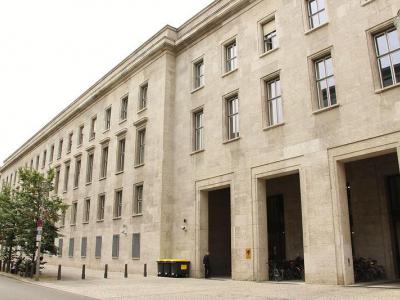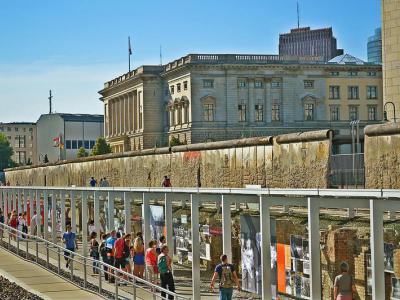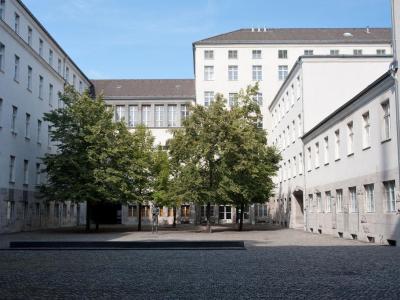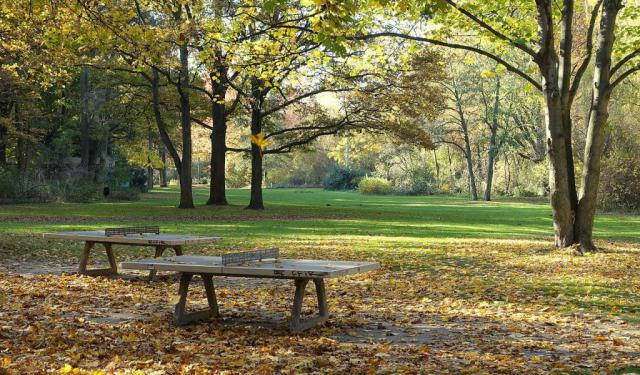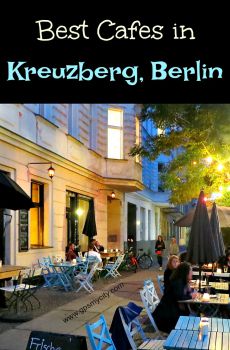
Third Reich Walking Tour (Self Guided), Berlin
The “Third Reich” and “Nazi Germany” are the common English names for Germany between 1933 and 1945, when it was a totalitarian state led by Adolf Hitler and the National Socialist German Workers’ Party. For any visitor to Berlin, the Nazi surrender that ended World War II is still a point of interest, but matching locations to those moments of history can be a challenge. On this special self-guided tour, we’ll make your quest for some key sights as easy and insightful as possible.
Begin your journey with the Reichstag – current home of the German Parliament, boasting a prime location on the banks of the Spree. Over the years, it has survived Nazi rule, wars, bombings, the country’s division and even a fire. In 1933, only a month after Hitler’s rise to power, the building was subject to a mysterious arson attack and almost destroyed by flames. The Nazis alleged that it was part of a Communist conspiracy to seize power, and shortly thereafter the entire Communist Party of Germany was arrested, thus leaving the Nazi Party unchallenged. This enabled Hitler to consolidate his power as Führer und Reichskanzler ("Leader and National Chancellor").
Make sure to also visit Goebbels’ Propaganda Ministry and Goering’s Air Force Headquarters – the largest office building in Europe at the time of its construction, described as “in the typical style of National Socialist intimidation architecture” by one writer. In these two institutions, at the height of the Third Reich, promotion occurred far more rapidly than in other departments, heavier weighting was given to party affiliation, and nepotism and corruption were rife.
By fate or coincidence, the Holocaust Memorial stands within close proximity of the Führerbunker site – where, during the last bitter days of WWII, Hitler committed suicide as a defeated oppressor. Destroyed and flooded after the war, the area now hosts an information board showing the layout of the structure.
To see an outstanding amount of WWII and post-war material, head to the Topography of Terror Museum, which rounds out the walking tour.
Begin your journey with the Reichstag – current home of the German Parliament, boasting a prime location on the banks of the Spree. Over the years, it has survived Nazi rule, wars, bombings, the country’s division and even a fire. In 1933, only a month after Hitler’s rise to power, the building was subject to a mysterious arson attack and almost destroyed by flames. The Nazis alleged that it was part of a Communist conspiracy to seize power, and shortly thereafter the entire Communist Party of Germany was arrested, thus leaving the Nazi Party unchallenged. This enabled Hitler to consolidate his power as Führer und Reichskanzler ("Leader and National Chancellor").
Make sure to also visit Goebbels’ Propaganda Ministry and Goering’s Air Force Headquarters – the largest office building in Europe at the time of its construction, described as “in the typical style of National Socialist intimidation architecture” by one writer. In these two institutions, at the height of the Third Reich, promotion occurred far more rapidly than in other departments, heavier weighting was given to party affiliation, and nepotism and corruption were rife.
By fate or coincidence, the Holocaust Memorial stands within close proximity of the Führerbunker site – where, during the last bitter days of WWII, Hitler committed suicide as a defeated oppressor. Destroyed and flooded after the war, the area now hosts an information board showing the layout of the structure.
To see an outstanding amount of WWII and post-war material, head to the Topography of Terror Museum, which rounds out the walking tour.
How it works: Download the app "GPSmyCity: Walks in 1K+ Cities" from Apple App Store or Google Play Store to your mobile phone or tablet. The app turns your mobile device into a personal tour guide and its built-in GPS navigation functions guide you from one tour stop to next. The app works offline, so no data plan is needed when traveling abroad.
Third Reich Walking Tour Map
Guide Name: Third Reich Walking Tour
Guide Location: Germany » Berlin (See other walking tours in Berlin)
Guide Type: Self-guided Walking Tour (Sightseeing)
# of Attractions: 7
Tour Duration: 2 Hour(s)
Travel Distance: 4.0 Km or 2.5 Miles
Author: clare
Sight(s) Featured in This Guide:
Guide Location: Germany » Berlin (See other walking tours in Berlin)
Guide Type: Self-guided Walking Tour (Sightseeing)
# of Attractions: 7
Tour Duration: 2 Hour(s)
Travel Distance: 4.0 Km or 2.5 Miles
Author: clare
Sight(s) Featured in This Guide:
- Reichstag (Parliament Building)
- Holocaust Denkmal (Holocaust Memorial)
- Fuhrerbunker (Hitler's Bunker)
- Propagandaministerium (Goebbels' Propaganda Ministry)
- Reichsluftfahrtministerium (Goering's Ministry of Aviation)
- Topographie des Terrors (Topography of Terror)
- Gedenkstatte Deutscher Widerstand (German Resistance Memorial Center)
1) Reichstag (Parliament Building) (must see)
Reichstag is one of Berlin’s most enduring symbols. Its stone walls have borne witness to the tides of history, mirroring Germany’s tumultuous political evolution: from imperial unification, through dictatorship and division, to a modern democratic republic.
Once referring to the legislative body of the German Empire, today, the word “Reichstag” more commonly denotes the iconic building housing the country's parliament, Bundestag.
Following the unification of Germany in 1871, plans were laid to construct a grand hall for the newly formed state (“Second Reich”). Completed in 1894, the Neo-Baroque structure was intended to reflect the strength and unity of the empire. In 1916, amidst a world at war and against the wishes of Emperor Wilhelm II, the inscription—"To the German People"—was carved into the frieze above the entrance. Just two years later, with the empire dissolved, it was within these very walls that the German Republic was proclaimed.
In 1933, a fire engulfed the Reichstag—a blaze which the Nazi regime would exploit to issue the infamous decree, suspending civil liberties and consolidating authoritarian power. Thereafter, the building was no longer used for parliamentary functions during the Nazi era and instead served various other roles throughout the war.
The Second World War left the Reichstag in ruins. During the Cold War, the fractured remains of the building stood on the western side of a divided Berlin. Though no longer a seat of government, it occasionally hosted exhibitions, ceremonies, and even concerts during the 1980s.
Then, on the historic night of October 3rd, 1990, the Reichstag reclaimed its national significance. Within its restored chamber, the ceremony marking the official reunification of Germany was held—attended by Chancellor Helmut Kohl and numerous statesmen.
In the mid-1990s, the British architect Sir Norman Foster was commissioned to redesign the building. His intervention preserved historical scars—including Soviet graffiti etched in 1945—while introducing a strikingly modern glass dome. Completed in 1999, the dome serves as a powerful architectural metaphor for democratic transparency. Open to the public, it allows visitors to peer down into the debating chamber below, while its 360-degree panorama reveals the vast expanse of the capital. A sun-tracking shield ensures natural light floods the space without overwhelming glare.
Tip:
Plan your visit in advance, as security measures require booking and a valid ID for entry.
For those wishing to skip the queue, reserving a table at the Käfer DACHGARTEN restaurant provides expedited access.
Dress warmly—while the dome offers breathtaking views, its open windows invite Berlin’s brisk winds.
Once referring to the legislative body of the German Empire, today, the word “Reichstag” more commonly denotes the iconic building housing the country's parliament, Bundestag.
Following the unification of Germany in 1871, plans were laid to construct a grand hall for the newly formed state (“Second Reich”). Completed in 1894, the Neo-Baroque structure was intended to reflect the strength and unity of the empire. In 1916, amidst a world at war and against the wishes of Emperor Wilhelm II, the inscription—"To the German People"—was carved into the frieze above the entrance. Just two years later, with the empire dissolved, it was within these very walls that the German Republic was proclaimed.
In 1933, a fire engulfed the Reichstag—a blaze which the Nazi regime would exploit to issue the infamous decree, suspending civil liberties and consolidating authoritarian power. Thereafter, the building was no longer used for parliamentary functions during the Nazi era and instead served various other roles throughout the war.
The Second World War left the Reichstag in ruins. During the Cold War, the fractured remains of the building stood on the western side of a divided Berlin. Though no longer a seat of government, it occasionally hosted exhibitions, ceremonies, and even concerts during the 1980s.
Then, on the historic night of October 3rd, 1990, the Reichstag reclaimed its national significance. Within its restored chamber, the ceremony marking the official reunification of Germany was held—attended by Chancellor Helmut Kohl and numerous statesmen.
In the mid-1990s, the British architect Sir Norman Foster was commissioned to redesign the building. His intervention preserved historical scars—including Soviet graffiti etched in 1945—while introducing a strikingly modern glass dome. Completed in 1999, the dome serves as a powerful architectural metaphor for democratic transparency. Open to the public, it allows visitors to peer down into the debating chamber below, while its 360-degree panorama reveals the vast expanse of the capital. A sun-tracking shield ensures natural light floods the space without overwhelming glare.
Tip:
Plan your visit in advance, as security measures require booking and a valid ID for entry.
For those wishing to skip the queue, reserving a table at the Käfer DACHGARTEN restaurant provides expedited access.
Dress warmly—while the dome offers breathtaking views, its open windows invite Berlin’s brisk winds.
2) Holocaust Denkmal (Holocaust Memorial) (must see)
Officially named The Memorial to the Murdered Jews of Europe, this solemn expanse of concrete, situated near Berlin’s Brandenburg Gate, stands as a stark and enduring tribute to the millions of Jewish lives extinguished under the Nazi regime between the years 1933 and 1945.
Unveiled in 2005, the memorial was conceived by American architect Peter Eisenman. It spans nearly 19,000 square meters and consists of more than 2,700 concrete stelae—each of varying height and dimension—arranged in a strict grid across a subtly sloping field. The result is a landscape that is simultaneously orderly and disorienting.
Though the design is intentionally abstract and, according to its creator, devoid of explicit symbolism, its resemblance to a graveyard is unmistakable. Some interpret the sea of grey pillars as evoking unmarked graves or the cold efficiency of a bureaucratic system that facilitated mass murder. Others see in its rigid structure a metaphor for a state that lost its humanity behind walls of administration and ideology.
As one moves deeper into the memorial, the concrete blocks grow taller, eclipsing the cityscape and swallowing sound. The sensation is deliberate. It conveys isolation, loss of identity, and the disorienting fear that accompanied the systematic persecution of Jews under the Third Reich. The path dips downward, suggesting the slow descent into darkness that defined those years.
The unfinished quality of some surfaces serves as a quiet reminder: remembrance is not complete, and history’s wounds do not fully heal. The fragmentation of space may reflect the fragmented memories of survivors—and of those lost, whose stories were never told.
This memorial does not offer resolution or unity. It does not attempt to console. Instead, it confronts. It calls forth reflection—on individual memory, on collective guilt, and on the enduring responsibility to remember, in a world where forgetting is all too easy...
Unveiled in 2005, the memorial was conceived by American architect Peter Eisenman. It spans nearly 19,000 square meters and consists of more than 2,700 concrete stelae—each of varying height and dimension—arranged in a strict grid across a subtly sloping field. The result is a landscape that is simultaneously orderly and disorienting.
Though the design is intentionally abstract and, according to its creator, devoid of explicit symbolism, its resemblance to a graveyard is unmistakable. Some interpret the sea of grey pillars as evoking unmarked graves or the cold efficiency of a bureaucratic system that facilitated mass murder. Others see in its rigid structure a metaphor for a state that lost its humanity behind walls of administration and ideology.
As one moves deeper into the memorial, the concrete blocks grow taller, eclipsing the cityscape and swallowing sound. The sensation is deliberate. It conveys isolation, loss of identity, and the disorienting fear that accompanied the systematic persecution of Jews under the Third Reich. The path dips downward, suggesting the slow descent into darkness that defined those years.
The unfinished quality of some surfaces serves as a quiet reminder: remembrance is not complete, and history’s wounds do not fully heal. The fragmentation of space may reflect the fragmented memories of survivors—and of those lost, whose stories were never told.
This memorial does not offer resolution or unity. It does not attempt to console. Instead, it confronts. It calls forth reflection—on individual memory, on collective guilt, and on the enduring responsibility to remember, in a world where forgetting is all too easy...
3) Fuhrerbunker (Hitler's Bunker)
Beneath the once-imposing gardens of the New Reich Chancellery in Berlin lay a grim vestige of the Third Reich: Hitler's Bunker. This heavily fortified underground labyrinth of concrete chambers became the final command center of Adolf Hitler and the collapsing Nazi regime during the waning months of the Second World War.
On the 16th of January, 1945, Hitler withdrew into this subterranean stronghold. Within its confines, he marked his 56th birthday on April 20 and, in a final gesture of defiance or despair, wed Eva Braun on the night of April 29. Less than twenty-four hours later, on April 30, the couple ended their lives—Hitler with a pistol, Braun by cyanide.
According to accounts from those present, their corpses were swiftly carried out into the garden of the Chancellery, doused with approximately 200 liters of petrol, and set alight. Loyal followers stood watch as their remains were consumed by flame, offering Nazi salutes as the regime’s symbol was reduced to ash.
Outside, the Red Army had breached the city. The Soviet banner soon flew over the Reichstag. Inside the bunker, panic reigned. Of the roughly 800 individuals sheltering within, many attempted escape through the shattered rail tunnels of northern Berlin. Only around one hundred of them would evade death or capture.
In the aftermath of war, Soviet forces razed both the old and new Chancellery buildings. Yet this bunker, buried deep and defiant, resisted complete destruction. It remained largely intact until the late 1980s, when Berlin’s urban redevelopment exposed—and ultimately dismantled—much of the remaining structure.
For decades, the site was unmarked, quietly covered over by modern life. Not until 2006 did a modest plaque appear, offering visitors a schematic and somber description of what had once been. Today, the bunker's emergency exit—once a passage to the Chancellery gardens—rests beneath an ordinary parking lot, its history hidden in plain sight.
On the 16th of January, 1945, Hitler withdrew into this subterranean stronghold. Within its confines, he marked his 56th birthday on April 20 and, in a final gesture of defiance or despair, wed Eva Braun on the night of April 29. Less than twenty-four hours later, on April 30, the couple ended their lives—Hitler with a pistol, Braun by cyanide.
According to accounts from those present, their corpses were swiftly carried out into the garden of the Chancellery, doused with approximately 200 liters of petrol, and set alight. Loyal followers stood watch as their remains were consumed by flame, offering Nazi salutes as the regime’s symbol was reduced to ash.
Outside, the Red Army had breached the city. The Soviet banner soon flew over the Reichstag. Inside the bunker, panic reigned. Of the roughly 800 individuals sheltering within, many attempted escape through the shattered rail tunnels of northern Berlin. Only around one hundred of them would evade death or capture.
In the aftermath of war, Soviet forces razed both the old and new Chancellery buildings. Yet this bunker, buried deep and defiant, resisted complete destruction. It remained largely intact until the late 1980s, when Berlin’s urban redevelopment exposed—and ultimately dismantled—much of the remaining structure.
For decades, the site was unmarked, quietly covered over by modern life. Not until 2006 did a modest plaque appear, offering visitors a schematic and somber description of what had once been. Today, the bunker's emergency exit—once a passage to the Chancellery gardens—rests beneath an ordinary parking lot, its history hidden in plain sight.
4) Propagandaministerium (Goebbels' Propaganda Ministry)
In the wake of Adolf Hitler’s appointment as Reich Chancellor in January of 1933, a new chapter in the orchestration of power began. Among those swiftly rewarded for their unwavering loyalty was Joseph Goebbels, the chief propagandist of the Nazi Party. For his instrumental role in securing Nazi control, Goebbels was named Reich Minister of Public Enlightenment and Propaganda—a newly created position that placed him at the heart of the Third Reich’s inner circle.
His ministry took up residence in the stately Leopold Palace, an 18th-century edifice situated just opposite Hitler’s own offices in the Reich Chancellery. From this historic vantage, the Ministry assumed sweeping control over every aspect of German cultural and intellectual life. The press, literature, visual arts, theatre, cinema, music, and radio—all were brought under its strict dominion. The unspoken objective was as ambitious as it was insidious: to present an image, both at home and abroad, of a unified Germany rallying behind the Führer with unshakable devotion.
Central to this propaganda machine was the elevation of Hitler himself. He was portrayed not merely as a statesman but as a messianic figure—flawless, heroic, and destined to lead. While some of the public’s admiration was genuine, much was carefully cultivated. The 1934 Nuremberg Rally stands as an early example of such orchestration. This mass gathering, meticulously staged for cinematic effect, was immortalized in the film "Triumph of the Will", directed by Leni Riefenstahl—one of several productions that blended art with ideology to powerful effect.
The Ministry's growth mirrored the ambitions of the regime. From a modest beginning in 1933 with just five departments and 350 employees, it expanded rapidly. By the outbreak of war in 1939, it encompassed 17 departments and a workforce exceeding 2,000. As the Second World War unfolded, the intensity of propaganda surged. Emerging media—film, radio, and newsreels—became vital instruments in shaping opinion and morale. Drawing on both practical expertise and academic study from Europe and the United States, Nazi propagandists ushered in a grim new era of psychological warfare, where words, images, and sound were as potent as any weapon on the battlefield.
His ministry took up residence in the stately Leopold Palace, an 18th-century edifice situated just opposite Hitler’s own offices in the Reich Chancellery. From this historic vantage, the Ministry assumed sweeping control over every aspect of German cultural and intellectual life. The press, literature, visual arts, theatre, cinema, music, and radio—all were brought under its strict dominion. The unspoken objective was as ambitious as it was insidious: to present an image, both at home and abroad, of a unified Germany rallying behind the Führer with unshakable devotion.
Central to this propaganda machine was the elevation of Hitler himself. He was portrayed not merely as a statesman but as a messianic figure—flawless, heroic, and destined to lead. While some of the public’s admiration was genuine, much was carefully cultivated. The 1934 Nuremberg Rally stands as an early example of such orchestration. This mass gathering, meticulously staged for cinematic effect, was immortalized in the film "Triumph of the Will", directed by Leni Riefenstahl—one of several productions that blended art with ideology to powerful effect.
The Ministry's growth mirrored the ambitions of the regime. From a modest beginning in 1933 with just five departments and 350 employees, it expanded rapidly. By the outbreak of war in 1939, it encompassed 17 departments and a workforce exceeding 2,000. As the Second World War unfolded, the intensity of propaganda surged. Emerging media—film, radio, and newsreels—became vital instruments in shaping opinion and morale. Drawing on both practical expertise and academic study from Europe and the United States, Nazi propagandists ushered in a grim new era of psychological warfare, where words, images, and sound were as potent as any weapon on the battlefield.
5) Reichsluftfahrtministerium (Goering's Ministry of Aviation)
Back in the 1930s, in the heart of Berlin appeared a structure emblematic of power, ambition, and the chilling efficiency of the Nazi regime: Hermann Göring’s Ministry of Aviation. At the time of its completion, it was the largest office building in Europe—an architectural colossus and a cornerstone of the burgeoning Luftwaffe bureaucracy. Spanning an immense 112,000 square meters, this seven-story edifice comprised 2,800 rooms, over 4,000 windows, and more than 7 kilometers of corridors. It was said to embody the very essence of National Socialist intimidation—monumental, unyielding, and meticulously ordered.
Constructed in a mere 18 months, with workers laboring day and night—even Sundays—the first 1,000 rooms were completed in just eight months. No fewer than 50 quarries supplied the stone, and by its inauguration, some 4,000 bureaucrats and their secretaries had taken up residence within its walls. The building also housed Germany’s civil aviation authority, consolidating the instruments of aerial power under one roof.
Remarkably, amid the devastation of Berlin in 1944 and 1945, the Ministry of Aviation endured. While much of the city lay in ruins, this monolithic structure escaped serious damage. In the aftermath of the Third Reich’s collapse, it passed into Soviet hands, serving as headquarters for the Soviet military administration from 1945 to 1948. During this time, between 1947 and 1949, it also became home to the German Economic Commission—the administrative nucleus of the Soviet Occupation Zone.
A new chapter unfolded in the early 1950s. Along Leipziger Street, behind the building’s imposing columns, an 18-meter mural came to life. Crafted from Meissen porcelain tiles, it was designed by artist Max Lingner with the aid of 14 craftsmen. The scene portrayed the Socialist dream—smiling East Germans united as a single, contented family, gazing toward a radiant future.
Following the reunification of Germany, between 1991 and 1995, the former Nazi stronghold became the seat of the Trust Establishment charged with privatizing East Germany’s state-run enterprises. Its chairman, Detlev Rohwedder, was assassinated by terrorists of the Red Army Faction in 1991. In his memory, the building was renamed the Detlev-Rohwedder-Haus.
Since 1990, the edifice has also housed the Federal Ministry of Finance. Following extensive renovations completed in 1999, it continues to serve this role—its long and complex history etched into every stone and corridor. A building born in tyranny, reshaped by occupation, and carried forward into democracy.
Constructed in a mere 18 months, with workers laboring day and night—even Sundays—the first 1,000 rooms were completed in just eight months. No fewer than 50 quarries supplied the stone, and by its inauguration, some 4,000 bureaucrats and their secretaries had taken up residence within its walls. The building also housed Germany’s civil aviation authority, consolidating the instruments of aerial power under one roof.
Remarkably, amid the devastation of Berlin in 1944 and 1945, the Ministry of Aviation endured. While much of the city lay in ruins, this monolithic structure escaped serious damage. In the aftermath of the Third Reich’s collapse, it passed into Soviet hands, serving as headquarters for the Soviet military administration from 1945 to 1948. During this time, between 1947 and 1949, it also became home to the German Economic Commission—the administrative nucleus of the Soviet Occupation Zone.
A new chapter unfolded in the early 1950s. Along Leipziger Street, behind the building’s imposing columns, an 18-meter mural came to life. Crafted from Meissen porcelain tiles, it was designed by artist Max Lingner with the aid of 14 craftsmen. The scene portrayed the Socialist dream—smiling East Germans united as a single, contented family, gazing toward a radiant future.
Following the reunification of Germany, between 1991 and 1995, the former Nazi stronghold became the seat of the Trust Establishment charged with privatizing East Germany’s state-run enterprises. Its chairman, Detlev Rohwedder, was assassinated by terrorists of the Red Army Faction in 1991. In his memory, the building was renamed the Detlev-Rohwedder-Haus.
Since 1990, the edifice has also housed the Federal Ministry of Finance. Following extensive renovations completed in 1999, it continues to serve this role—its long and complex history etched into every stone and corridor. A building born in tyranny, reshaped by occupation, and carried forward into democracy.
6) Topographie des Terrors (Topography of Terror) (must see)
In the place where tyranny once took root and festered now stands the Topography of Terror—an open wound of memory carved into the very ground that bore witness to some of the darkest chapters of the 20th century. This site marks the former location of the Gestapo and SS headquarters, epicenters of persecution, intimidation, and state-sanctioned terror under the Nazi regime.
Though Allied bombing in early 1945 reduced much of the complex to rubble, and the remnants were later cleared away, one part remained—the original outer wall. It now frames an outdoor historical exhibition, where a chronological procession of images and documents lays bare the machinery of oppression. Here, history is neither softened nor forgotten.
Just beyond, visitors can descend into the excavated basement of a Gestapo building, preserved from the era of the Third Reich. These remnants of stone and steel speak with a quiet finality—a stark reminder of how systematic cruelty was carried out behind closed doors.
Within a modern, thoughtfully constructed museum building adjacent to the site, the story continues. The indoor exhibition is a comprehensive and unsparing exploration of the rise of National Socialism and its catastrophic consequences, not only for Germany but for Europe and the world. Through meticulously curated photographs, letters, official documents, and audiovisual recordings, the exhibit provides both clarity and emotional depth, presenting an unflinching narrative while honoring the gravity of its subject matter.
Visitors are encouraged to make use of the free lockers before beginning the experience. A self-guided audio tour, rich in detail and historical context, is available and highly recommended. Facilities such as a café and restrooms offer a brief reprieve in what is otherwise a sobering journey through history.
Tip:
To begin your exploration of the outdoor memorial, start from the left side of the display panels. If visiting during colder months, dress appropriately—the open-air setting can be brisk. For those seeking an overview rather than an in-depth reading of each panel, consider the free English-language tour held every Sunday at 3:30 pm.
Though Allied bombing in early 1945 reduced much of the complex to rubble, and the remnants were later cleared away, one part remained—the original outer wall. It now frames an outdoor historical exhibition, where a chronological procession of images and documents lays bare the machinery of oppression. Here, history is neither softened nor forgotten.
Just beyond, visitors can descend into the excavated basement of a Gestapo building, preserved from the era of the Third Reich. These remnants of stone and steel speak with a quiet finality—a stark reminder of how systematic cruelty was carried out behind closed doors.
Within a modern, thoughtfully constructed museum building adjacent to the site, the story continues. The indoor exhibition is a comprehensive and unsparing exploration of the rise of National Socialism and its catastrophic consequences, not only for Germany but for Europe and the world. Through meticulously curated photographs, letters, official documents, and audiovisual recordings, the exhibit provides both clarity and emotional depth, presenting an unflinching narrative while honoring the gravity of its subject matter.
Visitors are encouraged to make use of the free lockers before beginning the experience. A self-guided audio tour, rich in detail and historical context, is available and highly recommended. Facilities such as a café and restrooms offer a brief reprieve in what is otherwise a sobering journey through history.
Tip:
To begin your exploration of the outdoor memorial, start from the left side of the display panels. If visiting during colder months, dress appropriately—the open-air setting can be brisk. For those seeking an overview rather than an in-depth reading of each panel, consider the free English-language tour held every Sunday at 3:30 pm.
7) Gedenkstatte Deutscher Widerstand (German Resistance Memorial Center)
The German Resistance Memorial Center in Berlin’s Mitte district is a solemn tribute to one of the most courageous yet tragic chapters of World War II. It commemorates the events of July 20th, 1944, when a group of German officers and civilians launched a daring coup in defiance of Adolf Hitler’s brutal National Socialist regime. History remembers it as the "20 July Plot" — or, in military circles, "Operation Valkyrie."
At the center of this audacious undertaking was Colonel Claus von Stauffenberg — a man whose patriotic conscience had turned against the very government he once served. Disillusioned by Hitler’s tyranny and the atrocities perpetrated under his rule, Stauffenberg became convinced that only the Führer’s death could halt the madness and restore honor to Germany.
On that fateful day, July 20th, 1944, Stauffenberg entered the Wolf’s Lair — Hitler’s heavily guarded headquarters in East Prussia — carrying a bomb concealed within a briefcase. Placing it beneath a table during a strategic meeting, he departed, believing the course of history was about to change. The explosion that followed wrought destruction and death — but not the death of Hitler. The dictator survived, shielded by sheer chance and a heavy oak table leg.
The aftermath was swift and merciless. The failed attempt unraveled the network of conspirators. Arrests, interrogations, and executions followed in grim succession. The dream of a new Germany — free from the grip of tyranny — was extinguished in blood.
Today, the German Resistance Memorial Center preserves the very spaces where the plotters once walked and planned. Within its courtyards and chambers, their legacy endures — not as traitors, but as visionaries of courage and conscience. Through its exhibitions and memorials, the Center calls on each visitor to reflect on the weight of resistance, the cost of integrity, and the enduring struggle for freedom in the darkest of times.
At the center of this audacious undertaking was Colonel Claus von Stauffenberg — a man whose patriotic conscience had turned against the very government he once served. Disillusioned by Hitler’s tyranny and the atrocities perpetrated under his rule, Stauffenberg became convinced that only the Führer’s death could halt the madness and restore honor to Germany.
On that fateful day, July 20th, 1944, Stauffenberg entered the Wolf’s Lair — Hitler’s heavily guarded headquarters in East Prussia — carrying a bomb concealed within a briefcase. Placing it beneath a table during a strategic meeting, he departed, believing the course of history was about to change. The explosion that followed wrought destruction and death — but not the death of Hitler. The dictator survived, shielded by sheer chance and a heavy oak table leg.
The aftermath was swift and merciless. The failed attempt unraveled the network of conspirators. Arrests, interrogations, and executions followed in grim succession. The dream of a new Germany — free from the grip of tyranny — was extinguished in blood.
Today, the German Resistance Memorial Center preserves the very spaces where the plotters once walked and planned. Within its courtyards and chambers, their legacy endures — not as traitors, but as visionaries of courage and conscience. Through its exhibitions and memorials, the Center calls on each visitor to reflect on the weight of resistance, the cost of integrity, and the enduring struggle for freedom in the darkest of times.
Walking Tours in Berlin, Germany
Create Your Own Walk in Berlin
Creating your own self-guided walk in Berlin is easy and fun. Choose the city attractions that you want to see and a walk route map will be created just for you. You can even set your hotel as the start point of the walk.
Berlin Introduction Walking Tour
The German capital, Berlin, is known for its turbulent past. Today, this sprawling metropolis is filled with a mix of historical resonance and modernity manifested in creative industries, popular media, and diverse cultural tourism.
The first written records of settlements in the present-day Berlin area date back to the late 12th century. In 1157, the region came under German rule as part of... view more
Tour Duration: 2 Hour(s)
Travel Distance: 4.0 Km or 2.5 Miles
The first written records of settlements in the present-day Berlin area date back to the late 12th century. In 1157, the region came under German rule as part of... view more
Tour Duration: 2 Hour(s)
Travel Distance: 4.0 Km or 2.5 Miles
Tiergarten Walking Tour
Known for the huge park of the same name, which once was a royal hunting ground, the central district of Tiergarten (German for “Animal Garden”) is home to the Berlin Zoo, the Victory Column with its winged statue and the lively, lakeside Café am Neuen See.
Begin your exploration at Postdamer Platz, the historic central square of Berlin, once regarded in the same way as Piccadilly Circus... view more
Tour Duration: 2 Hour(s)
Travel Distance: 3.4 Km or 2.1 Miles
Begin your exploration at Postdamer Platz, the historic central square of Berlin, once regarded in the same way as Piccadilly Circus... view more
Tour Duration: 2 Hour(s)
Travel Distance: 3.4 Km or 2.1 Miles
Alexanderplatz Walking Tour
One of Berlin’s cosmopolitan hearts, Alexanderplatz (or Alexander Square) is a true hive of activity. There is always something going on here: Christmas markets, Easter fairs, buskers, performances, Oktoberfest, and the list is countless. Easily accessible, with lots of transport connections and all manner of drink and food outlets, it’s a great place to hang around, take photos, and enjoy... view more
Tour Duration: 1 Hour(s)
Travel Distance: 1.6 Km or 1 Miles
Tour Duration: 1 Hour(s)
Travel Distance: 1.6 Km or 1 Miles
Berlin Food Walking Tour
While Berlin may not be considered a typical foodie destination yet, recent years saw a growing number of decent places to eat, serving both German and international cuisine. At some point, the city has even earned itself the title of a vegetarian capital of the world, contrary to what one may have expected. Amid all this renaissance in creativity and culture, coupled with the influx of the... view more
Tour Duration: 1 Hour(s)
Travel Distance: 1.4 Km or 0.9 Miles
Tour Duration: 1 Hour(s)
Travel Distance: 1.4 Km or 0.9 Miles
Museum Island Walking Tour
One of Berlin’s most visited attractions, the Museum Island ("Museumsinsel") complex was established by order of King Frederick William IV of Prussia in 1841 and houses several world-famous museums kept in close vicinity of each other. The island itself is spectacular for a walk, with wonderful architecture, statues, gardens and trees, so enjoy the atmosphere and make at least a day... view more
Tour Duration: 1 Hour(s)
Travel Distance: 1.2 Km or 0.7 Miles
Tour Duration: 1 Hour(s)
Travel Distance: 1.2 Km or 0.7 Miles
Useful Travel Guides for Planning Your Trip
Best Bars in Kreuzberg, Berlin
Kreuzberg and "Kreuzkölln" - the area where Kreuzberg and Neukölln meet, mostly along the canal in east Kreuzberg and north of Sonnenallée in Neukölln - has a constantly and rapidly evolving bar culture that makes it one of the trendiest alternative evening and nightlife spots in...
Best Cafés and Coffee Houses of Berlin
Cafes have a certain refinery and elegance that pubs lack; there is a mellowness that is rarely found in bars and clubs, and an ease and tranquillity that is not to be found in restaurants with their steaming kitchens, heavy plates, clattering cutlery, constant complaints and corrections and,...
Best Cafes in Kreuzberg, Berlin
Traditionally, you may expect the cafes around Kottbusser Tor and throughout Kreuzberg to be dominated by ethnic Turks, particularly men, in rooms that do much to resemble the cafes of Istanbul.
More recently, however, the ethnically Turkish and Arab communities that have typically inhabited...
Best Food in Kreuzberg, Berlin
Kreuzberg is known for having great cheap, street food, particularly of the Middle Eastern variety. On almost every corner you can find a kebab or falafel shop, although the trick is knowing which to choose! While you can typically get a good, tasty wrap for €2.50-4, the quality, quantity and...
A Self-Guided Food Walk in Berlin
Repeatedly scarred throughout its long and often depressing past, today's Berlin has made a comeback as a major bohemian hub which lures artists and creatively-minded folk from all over the globe in their droves. It may well not be considered a typical foodie destination yet, but in recent...
Berlin Mementos: 18 Souvenir Shopping Ideas for Travelers
Too many people and for very different reasons strove to set their foot in Berlin over the course of the 20th century. Today, the city proves just as luring a destination for numerous travelers who want to come and enjoy themselves in this fascinating European capital and, perhaps, bring home...
The Most Popular Cities
/ view all



